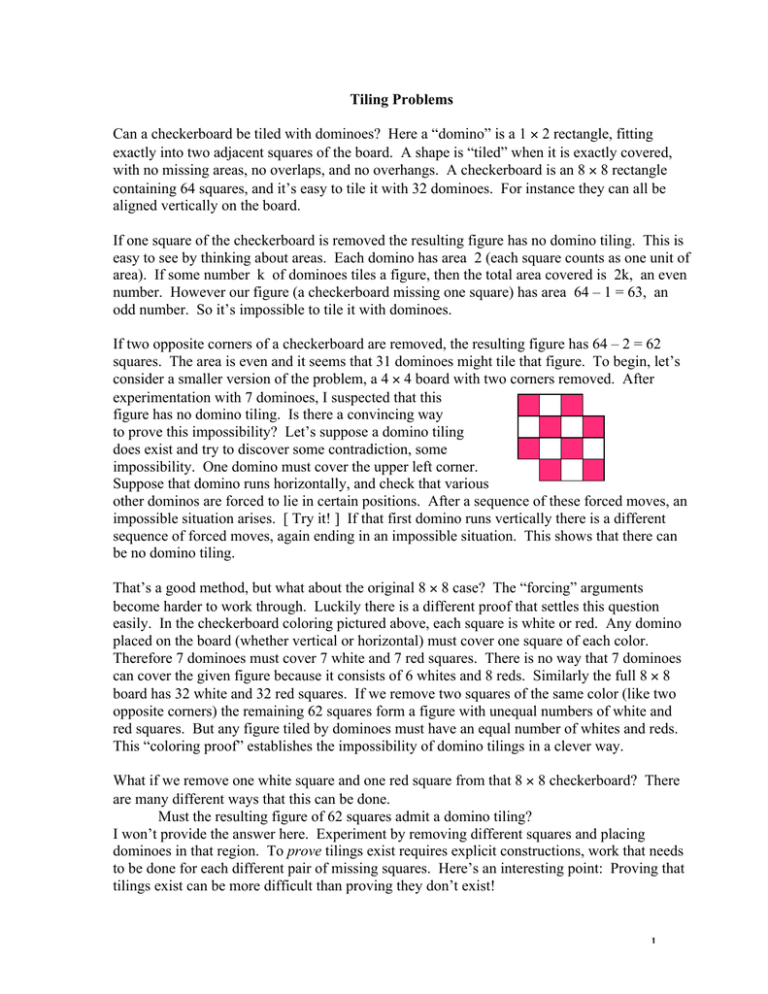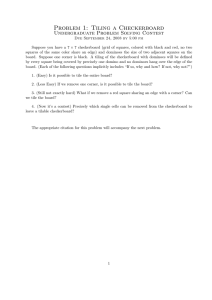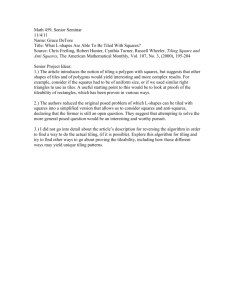1 Tiling Problems Can a checkerboard be tiled with dominoes? Here
advertisement

Tiling Problems Can a checkerboard be tiled with dominoes? Here a “domino” is a 1 ¥ 2 rectangle, fitting exactly into two adjacent squares of the board. A shape is “tiled” when it is exactly covered, with no missing areas, no overlaps, and no overhangs. A checkerboard is an 8 ¥ 8 rectangle containing 64 squares, and it’s easy to tile it with 32 dominoes. For instance they can all be aligned vertically on the board. If one square of the checkerboard is removed the resulting figure has no domino tiling. This is easy to see by thinking about areas. Each domino has area 2 (each square counts as one unit of area). If some number k of dominoes tiles a figure, then the total area covered is 2k, an even number. However our figure (a checkerboard missing one square) has area 64 – 1 = 63, an odd number. So it’s impossible to tile it with dominoes. If two opposite corners of a checkerboard are removed, the resulting figure has 64 – 2 = 62 squares. The area is even and it seems that 31 dominoes might tile that figure. To begin, let’s consider a smaller version of the problem, a 4 ¥ 4 board with two corners removed. After experimentation with 7 dominoes, I suspected that this figure has no domino tiling. Is there a convincing way to prove this impossibility? Let’s suppose a domino tiling does exist and try to discover some contradiction, some impossibility. One domino must cover the upper left corner. Suppose that domino runs horizontally, and check that various other dominos are forced to lie in certain positions. After a sequence of these forced moves, an impossible situation arises. [ Try it! ] If that first domino runs vertically there is a different sequence of forced moves, again ending in an impossible situation. This shows that there can be no domino tiling. That’s a good method, but what about the original 8 ¥ 8 case? The “forcing” arguments become harder to work through. Luckily there is a different proof that settles this question easily. In the checkerboard coloring pictured above, each square is white or red. Any domino placed on the board (whether vertical or horizontal) must cover one square of each color. Therefore 7 dominoes must cover 7 white and 7 red squares. There is no way that 7 dominoes can cover the given figure because it consists of 6 whites and 8 reds. Similarly the full 8 ¥ 8 board has 32 white and 32 red squares. If we remove two squares of the same color (like two opposite corners) the remaining 62 squares form a figure with unequal numbers of white and red squares. But any figure tiled by dominoes must have an equal number of whites and reds. This “coloring proof” establishes the impossibility of domino tilings in a clever way. What if we remove one white square and one red square from that 8 ¥ 8 checkerboard? There are many different ways that this can be done. Must the resulting figure of 62 squares admit a domino tiling? I won’t provide the answer here. Experiment by removing different squares and placing dominoes in that region. To prove tilings exist requires explicit constructions, work that needs to be done for each different pair of missing squares. Here’s an interesting point: Proving that tilings exist can be more difficult than proving they don’t exist! 1 Since dominoes worked well let’s generalize to “trominoes.” We use the straight tromino made of three squares in a row. Which boards can be tiled with those trominoes? For instance an 8 ¥ 8 board has no tromino tiling. To see this, note that a tromino has area 3 so a figure tiled by k trominoes has area 3k. The checkerboard area is 64, and 64 = 3k is impossible for a whole number k. Therefore no tromino tiling can exist. If one square is removed from the checkerboard, 63 squares remain. Here’s our main question: Can that figure be tiled with 21 straight trominoes? The areas match, but I tried removing a square and couldn’t find a valid tiling. Is a tiling always impossible no matter which square is missing? The red and white coloring trick doesn’t work very well here. Instead let’s use three colors as in the picture and try for a contradiction.. The key observation here is: Any straight tromino on the board (placed horizontally or vertically) must cover one square of each color. Suppose a square is removed and 21 straight trominoes do tile the remaining figure. Using our key observation, we see that the whole figure must contain exactly 21 squares of each color. For the whole 8 ¥ 8 board I count 22 reds, 21 blues, and 21 whites. So if a tiling exists, the square that was removed must be red. For instance if the upper right corner square is missing then no tiling by straight trominoes is possible (because the square removed is not red in our color pattern). What if we removed the upper left corner, colored red in the picture? The impossibility of a tiling does not follow by counting those colors. However if there is a tiling for the board with a missing upper left corner, we can turn the picture by a 90 degrees to exhibit a tiling for a board with a missing upper right corner. Since that case was already proved impossible, the board with a missing upper left corner is also impossible to tile. The color-counting and turning methods show that tiling by straight trominoes is impossible for most positions of the missing square. With a little thought we find that the only times there might possibly be a tiling are for the boards where the missing square is one of the red squares marked with a dot in the picture above (they stay red when the picture is turned). If one of those squares is removed from the board, can the figure be tiled? Draw a board, erase one of those squares, and try to tile it with straight trominoes. It can be done. We have now completely answered our question of which checkerboard-with-a-missing-square figures can be tiled with straight trominoes! ________________________________________________________________________ Many tiling questions can be analyzed by similar methods. Here are some for you to try: 1. Which m ¥ n boards can be tiled by the straight tetromino? For example, can a 10 ¥ 10 board be tiled with 25 of those tetrominoes? 2 2. Which m ¥ n boards can be tiled by copies of a 2 ¥ 3 block? Areas show that if there is a tiling then mn is a multiple of 6. Can a 6 ¥ 5 board be tiled? 3. Which m ¥ n boards can be tiled with copies of the L-tromino? It’s easy to tile a 2 ¥ 3 board. Can a 5 ¥ 9 board be tiled with L-trominoes? Many puzzles, patterns, and problems of this nature appear in the wonderful book Polyominoes, by Solomon W. Golomb. (Published by Princeton Univ. Press, Princeton NJ, 1994). 3

